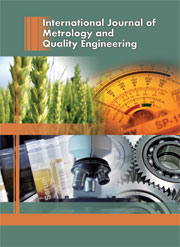Article contents
The design of a double ended interferometer (DEI)
Published online by Cambridge University Press: 02 December 2014
Abstract
At NMISA the SI unit for length is realised by an iodine stabilised He-Ne laser, an optical measurement. In industry most measurements are performed by mechanical probing. Gauge blocks are the link between the optical measurements and the mechanical measurements, and are therefore critical in disseminating traceability. The gauge block length is currently determined by wringing the gauge block onto a platen. This is laborious, requires skill and causes contact errors. Since around 1943, there have been efforts to build a double ended interferometer where gauge block length can be determined without wringing it onto a platen. While there has been a lot of progress in building DEIs, to date, there is still no commercially available DEI. We present a collaboration project between the National Metrology Institute of South Africa (NMISA), the National Institute of Standards (NIS Egypt) and Stellenbosch University (SUN) in South Africa to build a double ended interferometer for use at the respective National Metrology Institutes. We investigate improvements to the interferometric calibration of gauge blocks and recent developments. The different systems currently in use in the national metrology laboratories are described and various designs are investigated. Lastly the expected outcome of the project will be discussed.
- Type
- Research Article
- Information
- Copyright
- © EDP Sciences 2014
References
- 1
- Cited by




